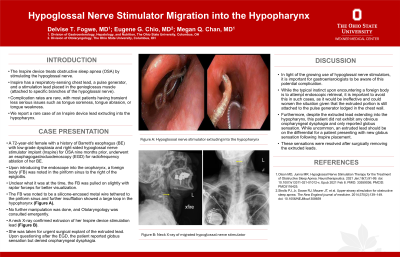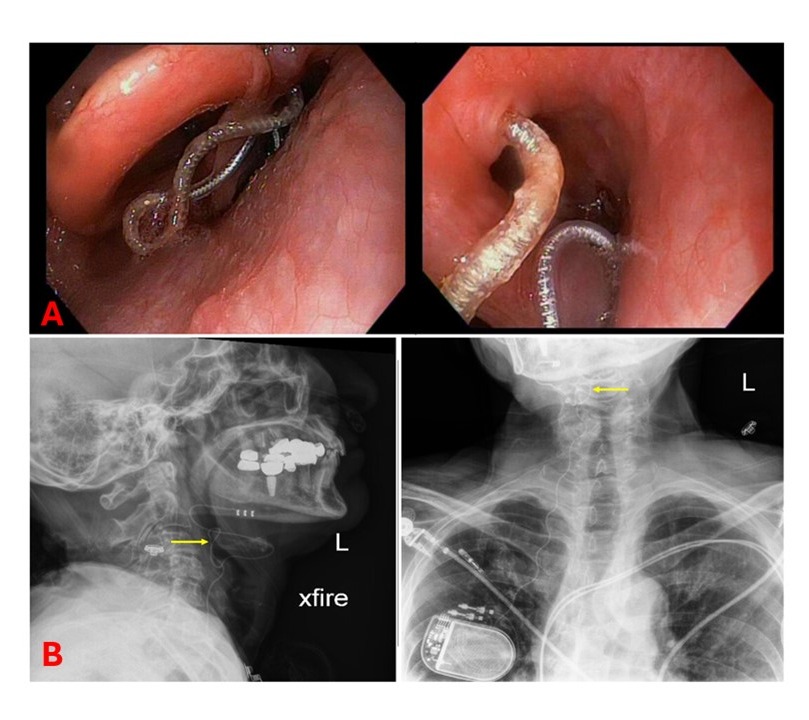Monday Poster Session
Category: Esophagus
P2303 - Hypoglossal Nerve Stimulator Migration Into the Hypopharynx
Monday, October 28, 2024
10:30 AM - 4:00 PM ET
Location: Exhibit Hall E

Has Audio
- DF
Delvise Fogwe, MD
The Ohio State University Wexner Medical Center
Columbus, OH
Presenting Author(s)
Delvise Fogwe, MD, Eugene Chio, MD, Megan Chan, MD
The Ohio State University Wexner Medical Center, Columbus, OH
Introduction: The Inspire device treats obstructive sleep apnea (OSA) by stimulating the hypoglossal nerve. It has a respiratory-sensing chest lead, a pulse generator, and a stimulation lead placed in the genioglossus muscle (attached to specific branches of the hypoglossal nerve). Complication rates are rare, with most patients having transient minor issues such, as tongue soreness, tongue abrasion, or tongue weakness. We report a rare case of an Inspire device lead extruding into the hypopharynx.
Case Description/Methods: A 72-year-old female with a history of Barrett's esophagus (BE) with low-grade dysplasia and right-sided hypoglossal nerve stimulator implant (Inspire) for OSA nine months prior, underwent an esophagogastroduodenoscopy (EGD) for radiofrequency ablation of her BE. Upon introducing the endoscope into the oropharynx, a foreign body (FB) was noted in the piriform sinus to the right of the epiglottis. Unclear what it was at the time, the FB was pulled on slightly with raptor forceps for better visualization. The FB was noted to be a silicone-encased metal wire tethered to the piriform sinus and further insufflation showed a large loop in the hypopharynx (Figure 1, A). No further manipulation was done, and Otolaryngology was consulted emergently. A neck X-ray confirmed extrusion of her Inspire device stimulation lead (Figure 1, B). She was taken for urgent surgical explant of the extruded lead. Upon questioning after the EGD, the patient reported globus sensation but denied oropharyngeal dysphagia.
Discussion: In light of the growing use of hypoglossal nerve stimulators, it is important for Gastroenterologists to be aware of this potential complication. There are currently no reports of similar cases. While the instinct upon encountering a foreign body is to attempt endoscopic retrieval, it is important to avoid this in such cases as it would be ineffective and could worsen the situation given that the extruded portion is still attached to the pulse generator lodged in the chest wall. Furthermore, despite the extruded lead extending into the hypopharynx, this patient did not exhibit any obvious oropharyngeal dysphagia and only reported bothersome globus sensation, which resolved after surgically removing the extruded lead. Airway compromise is another potential complication, but fortunately did not occur in this case due to timely interdisciplinary intervention.

Disclosures:
Delvise Fogwe, MD, Eugene Chio, MD, Megan Chan, MD. P2303 - Hypoglossal Nerve Stimulator Migration Into the Hypopharynx, ACG 2024 Annual Scientific Meeting Abstracts. Philadelphia, PA: American College of Gastroenterology.
The Ohio State University Wexner Medical Center, Columbus, OH
Introduction: The Inspire device treats obstructive sleep apnea (OSA) by stimulating the hypoglossal nerve. It has a respiratory-sensing chest lead, a pulse generator, and a stimulation lead placed in the genioglossus muscle (attached to specific branches of the hypoglossal nerve). Complication rates are rare, with most patients having transient minor issues such, as tongue soreness, tongue abrasion, or tongue weakness. We report a rare case of an Inspire device lead extruding into the hypopharynx.
Case Description/Methods: A 72-year-old female with a history of Barrett's esophagus (BE) with low-grade dysplasia and right-sided hypoglossal nerve stimulator implant (Inspire) for OSA nine months prior, underwent an esophagogastroduodenoscopy (EGD) for radiofrequency ablation of her BE. Upon introducing the endoscope into the oropharynx, a foreign body (FB) was noted in the piriform sinus to the right of the epiglottis. Unclear what it was at the time, the FB was pulled on slightly with raptor forceps for better visualization. The FB was noted to be a silicone-encased metal wire tethered to the piriform sinus and further insufflation showed a large loop in the hypopharynx (Figure 1, A). No further manipulation was done, and Otolaryngology was consulted emergently. A neck X-ray confirmed extrusion of her Inspire device stimulation lead (Figure 1, B). She was taken for urgent surgical explant of the extruded lead. Upon questioning after the EGD, the patient reported globus sensation but denied oropharyngeal dysphagia.
Discussion: In light of the growing use of hypoglossal nerve stimulators, it is important for Gastroenterologists to be aware of this potential complication. There are currently no reports of similar cases. While the instinct upon encountering a foreign body is to attempt endoscopic retrieval, it is important to avoid this in such cases as it would be ineffective and could worsen the situation given that the extruded portion is still attached to the pulse generator lodged in the chest wall. Furthermore, despite the extruded lead extending into the hypopharynx, this patient did not exhibit any obvious oropharyngeal dysphagia and only reported bothersome globus sensation, which resolved after surgically removing the extruded lead. Airway compromise is another potential complication, but fortunately did not occur in this case due to timely interdisciplinary intervention.

Figure: Figure 1: (A) Hypoglossal nerve stimulator extruding into the hypopharynx; (B) Neck X-ray of migrated hypoglossal nerve stimulator
Disclosures:
Delvise Fogwe indicated no relevant financial relationships.
Eugene Chio: Inspire Medical – Consultant. Nyxoah – Consultant.
Megan Chan indicated no relevant financial relationships.
Delvise Fogwe, MD, Eugene Chio, MD, Megan Chan, MD. P2303 - Hypoglossal Nerve Stimulator Migration Into the Hypopharynx, ACG 2024 Annual Scientific Meeting Abstracts. Philadelphia, PA: American College of Gastroenterology.
